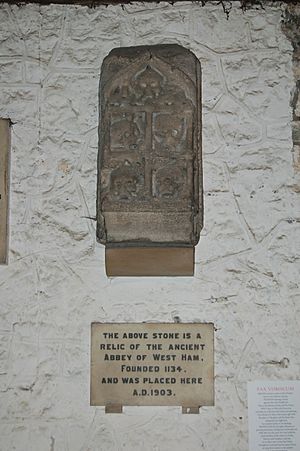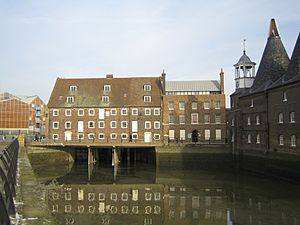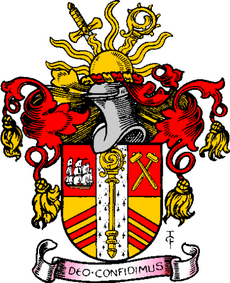Stratford Langthorne Abbey facts for kids

The Stratford Langthorne Abbey, also known as the Abbey of St Mary's, Stratford Langthorne, was a large Cistercian monastery. It was founded in 1135 in a place called Stratford Langthorne. This area was once part of Essex but is now in the London Borough of Newham.
People also called it West Ham Abbey because it was in that parish. It was one of the biggest Cistercian abbeys in England. The Abbey owned about 1,500 acres (6 square kilometers) of land nearby. It also controlled more than 20 large estates, called manors, across Essex.
The Abbey was very rich and could provide everything it needed for itself. Some of its money came from mills that ground wheat. These mills helped local bakers make bread for the City of London. This later caused problems with the Guild of Bakers, who wanted to charge a fee for bread entering the City.
Contents
History of the Abbey
How the Abbey Started
The Abbey began on July 25, 1135. A man named William de Montfichet gave the monks a lot of land. This included his whole lordship of West Ham, some meadow land, and two mills. He also gave them his wood from Buckhurst Hill.
The Abbey was dedicated to St Mary. It was a "daughter house" of Savigny Abbey in France. This meant it was connected to that larger abbey. In 1218, a rule was made that visiting monks could only stay for three days. But the next year, the rule changed. Monks could stay longer if they brought their own drinks and food for their horses.

The Abbey church started as a simple cross-shaped building. By the 13th century, it had grown much larger. It had a main church area called a presbytery, a walking area called an ambulatory, and small side chapels.
Around the church, there were buildings for lay brothers (monks who did manual work) and for guests. There were also workshops for brewing beer, shearing sheep, weaving cloth, and making leather. Farm buildings helped manage the Abbey's large land and mills. Some of these were tidal mills, like those at Three Mills. The Abbey owned these mills, but the ones you see today were built much later. During the 1200s, the Abbey got even more land in Essex and other places. This included the manor of Biggin.
Important Visitors and Challenges
In 1267, King Henry III even used the Abbey as his court for a while. He met with important church leaders there. It was also where he made peace with some powerful barons. Other kings visited the Abbey too. It became a popular place for important people to visit and even to be buried.
In 1338, the River Thames flooded badly. The monks had to move to their land in Great Burstead in Essex. In 1381, during the Peasants' Revolt, people broke into the Abbey. They took its goods and burned its important papers. The Abbey also suffered from more floods in the late 1300s. After this, King Richard II helped to fix it up.
In 1467, King Edward IV was a guest at the Abbey. He then promised to send two barrels of wine every year. This was for special church services held in his honor.
A small river port grew near Stratford in the 1400s. It helped the Abbey and its mills. Later, there were special docks for bricks and wood. But by 1920, the dock was filled in, and factories were built there. From 1613, water was taken from rivers to create canals and the New River. This supplied fresh water to London from Hertfordshire. This caused water levels to drop in some channels, and the traditional water mills stopped working.
The Abbey Closes Down
The Abbey lasted until 1538, when King Henry VIII closed down many monasteries. This event is known as the dissolution of the monasteries. Stratford Langthorne Abbey was the fifth largest in England. It was as important as other famous abbeys like Jervaulx, Rievaulx, and Fountains.
When the Abbey closed, its land was given to Sir Peter Meautas and his wife Johanna. This was a reward for their loyal service to the King. All the monks were given pensions (regular payments).
The Abbey was also responsible for maintaining a bridge at Bow. This bridge was built in 1177 to replace an old river crossing. At first, land and a mill were given to Barking Abbey to help maintain the bridge. But later, this job went to Stratford Langthorne Abbey. The leaders of both abbeys argued about who should pay. In 1315, they agreed that West Ham Abbey would maintain the bridge and road. Barking Abbey would pay them £200 each year.
After Stratford Langthorne Abbey closed, there were many long legal battles over who should maintain the bridge. In 1691, the new landowners were found responsible. The issue was finally settled in 1834 when a special trust was formed. The Abbey was also in charge of maintaining the sea wall around West Ham marsh. This led to more arguments with another nearby priory in 1339.
What Remains Today

The Abbey site was located between the Channelsea River and Marsh Lane (now Manor Road). You can't see any of the original buildings there today. Local landowners took much of the stone to build their own houses. By 1840, the North Woolwich railway was built right through the site. Factories and the Stratford wholesale Market were built on the remaining land.
However, a stone window and a carving of skulls are still visible. These are thought to have been above the door to the charnel house (a building for bones). You can see them in All Saints West Ham Parish Church, which dates from around 1180. The Abbey's Great Gate survived in Baker's Row until 1825.
Even though no Abbey buildings remain, archaeologists have done a lot of work there. In the early 1990s, they dug up the land for a new train depot. They found 647 burials from the Cistercian cemetery. These skeletons were later reburied at Mount St. Bernard Abbey in Leicestershire. Digging continues as old factories are redeveloped. In 2008, they found the Abbey's old gatehouse. This area is now protected as a Scheduled Ancient Monument. A community garden has been created there by the "Friends of Abbey Gardens".
The coat of arms of the Abbey can be seen over a doorway in Stratford today. The zig-zag shapes from this design, which came from the Mountfitchet family, were used in the coat of arms for the former County Borough of West Ham in 1887. An abbot's crozier (a special staff) was also added. The same arms were later adopted by the new London Borough of Newham in 1965.
The Abbey is remembered by two roads in the area: Abbey Lane and Abbey Road. Another street, Langthorne Street, used to be north of the Abbey site. It was destroyed during World War II and later disappeared under new buildings.
The Langthorne zig-zags were also used in the coat of arms for the former Municipal Borough of Leyton. This is because the Abbey owned a lot of land there. Langthorne Road and the old Langthorne Hospital in Leytonstone also remember the Abbey's influence.
Burials at the Abbey
Archaeologists found 647 burials in the church and the cemetery outside. Most of the skeletons were male, which is expected for a monastery. However, a few babies, children, and women were also found in all burial areas.
Some important people buried at the Abbey include:
Estates Held by the Abbey
The Abbey owned many estates, including:
- Great Burstead, Essex
- The manor of Biggin in Chadwell St Mary

